- Author: Christine Casey
I've had several questions recently about the Bambeco solitary bee house sold at Costco (they sell the Swiss Alps model), so I decided to head to my local store to check it out. While the price is amazing, the house has a few features that are not so ideal. For details on what makes a good solitary bee house, see here and here.
What's good: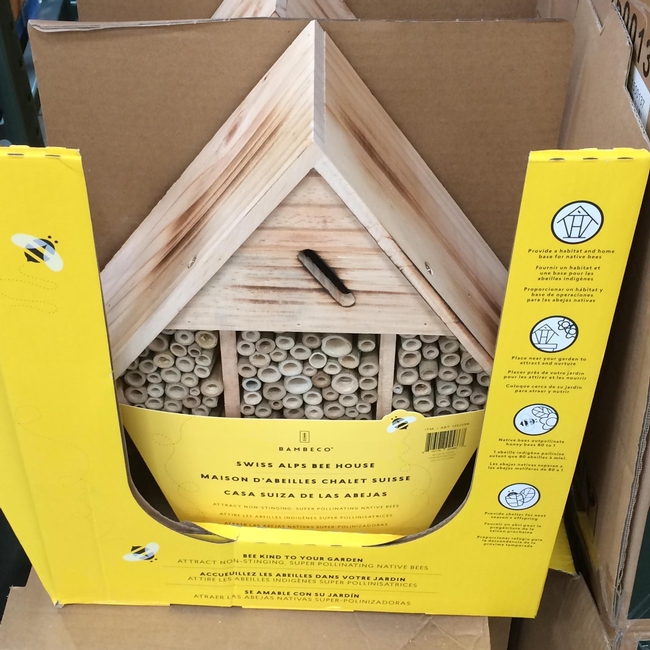
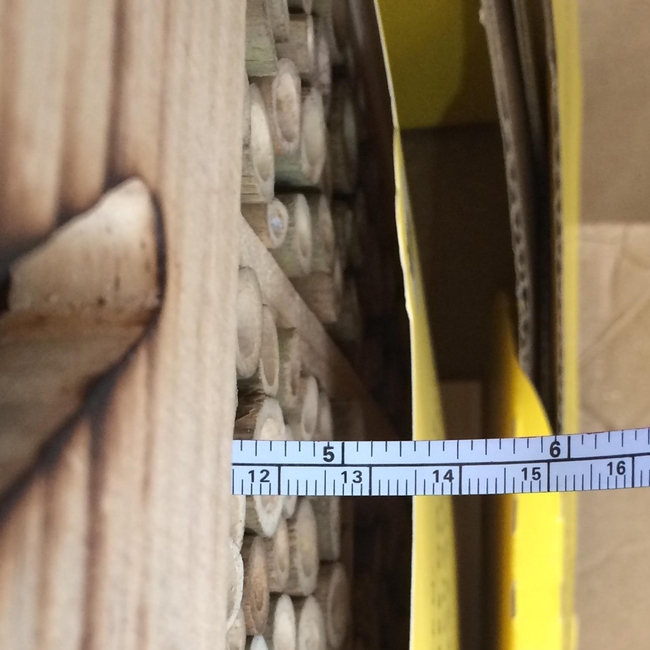
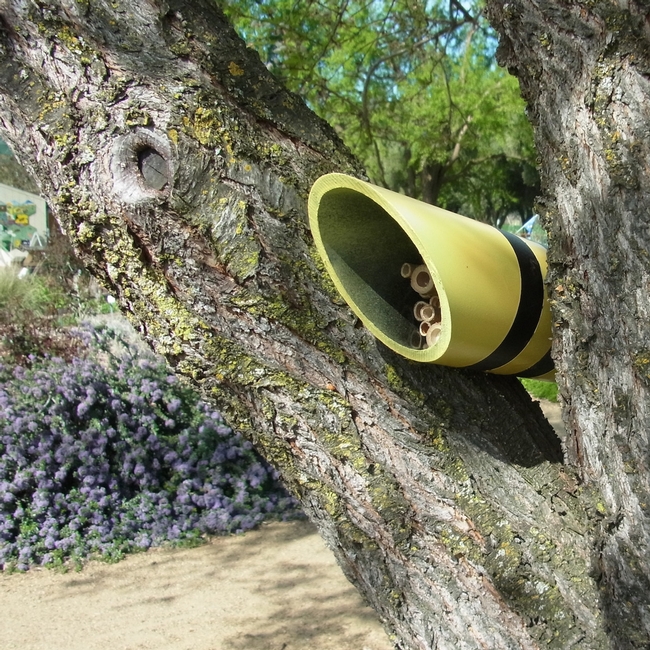
The depth. At 4.5 inches deep, it is sufficiently deep to allow the production of female and male bees.
What's not so good:
The nesting tube diameter. While the variety of diameters is good, solitary bees need tubes from 3/16 to 5/16 in diameter. While other arthropods, such as spiders, may use the larger tubes, they will not be used by bees.
Limited protected overhang. The nesting tubes should be placed so that the entrance has a bit of protection. That's why we make our houses at least an inch longer than the tubes.
The nesting tubes are glued in place. Once a tube is used it should be replaced to help prevent the build up of pathogens.
March 13, 2019: winter update
The bee house is not holding up well to the winter weather. Here's a photo showing some superficial mold as well as separation of the sides from the base. Note that I added extra protection by attached redwood fence boards to increase the cover of the roof.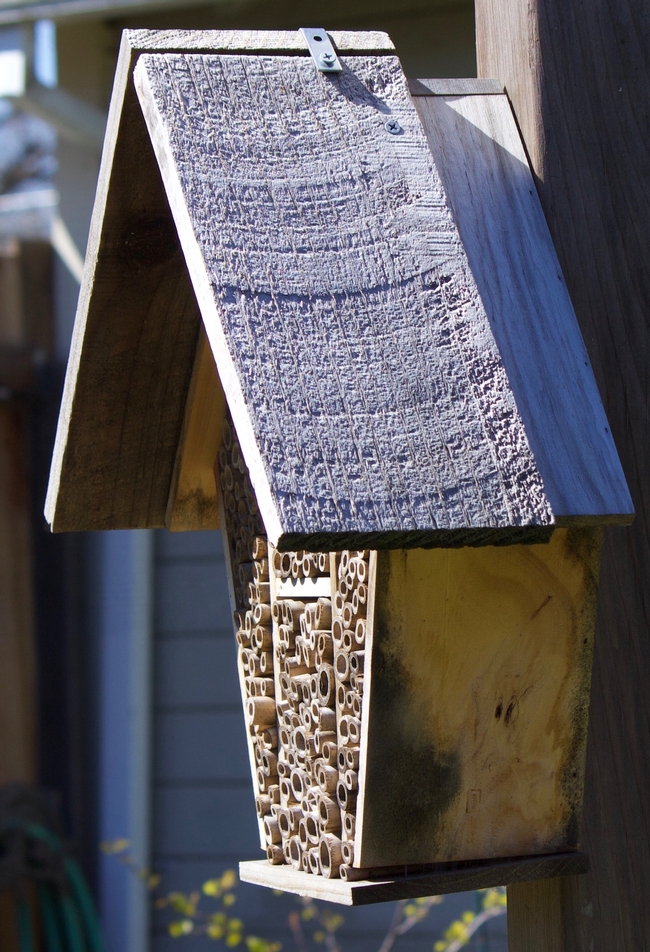
March 27, 2019: comments on the 2019 model
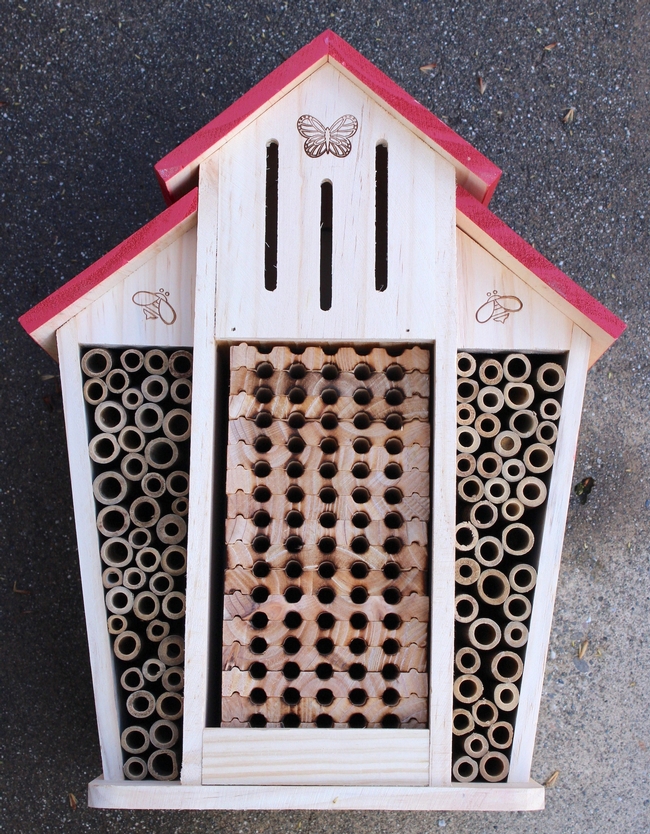


Update July 1, 2019
The Bambeco bee house shown above is not holding up well to the weather. After three months outside (there was one week of rain during this period), the paint on the roof is peeling.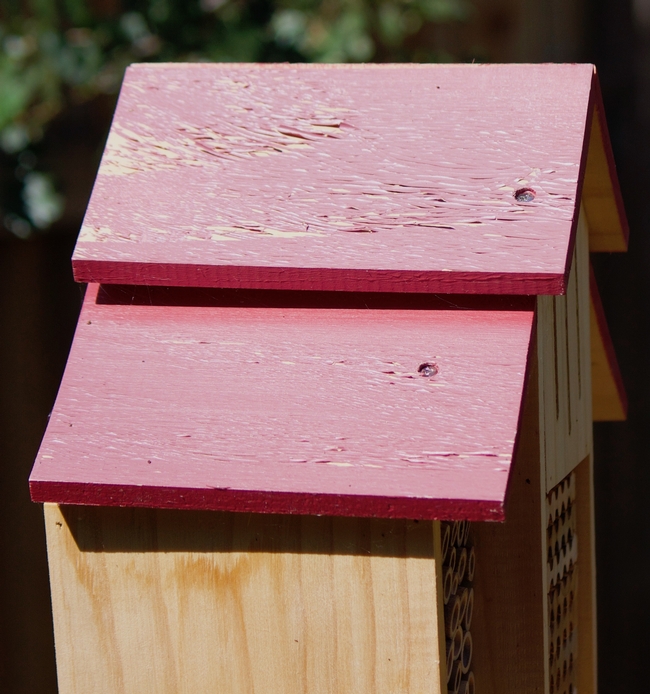
Update October 7, 2019
I have discarded the 2019 bee house. The paint continued to peel and the wood on the roof started to split. I removed the wooden blocks in the front of the house and will use these next year. For folks who have been asking what a correctly designed bee house looks like, here is an example of the one we sell at the Haven. 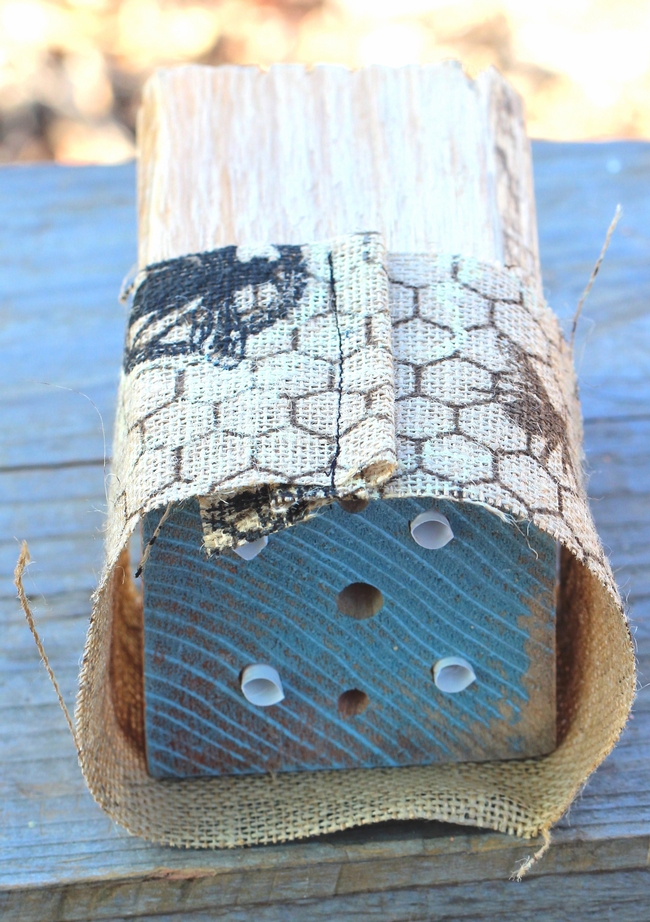
What makes it correct:
1. It's made out of redwood; studies have shown that bees prefer to nest in wood.
2. The depth and diameter of the nesting tubes are correct. The holes are drilled 5 inches deep, and the openings range from 3/16 to 5/16 inch in diameter.
3. Paper straws have been inserted into the 1/4 inch diameter holes (this is the only size straw available). This means that the tube can be cleaned out after use. I suggest plugging the others with wood filler after use so that they are not re-used.
4. The front of the block has a pattern to it. This may help the bees recognize their individual nest entrance. There is also evidence that a blue front is more attractive to one of the mason bee species.
5. The block has a piece of burlap shading the entrance. Bees are more likely to use the blocks if the entrance is shaded.




Last winter we had lots of rain (of course) and no rain messed up the bee house.
Just an idea from a newbie mason bee aficionado
I've not seen the new model in person, but from the pictures it looks similar to last year's. Still has nesting tubes of incorrect diameter that cannot be removed. It appears that they have added a space for butterflies on the top. Unfortunately the only study that I'm aware of found that butterfly houses were used mostly by spiders.
As far as hosting cavity-nesting bees in your garden goes, the bees do it all. It may take a few years for them to find your nests, but once they do they tend to return in subsequent years.
Is there a downside to having the larger openings/butterfly openings clear for spiders? Would they prey on the bees so they wouldn't come near the house? I don't mind keeping house for the spiders, but don't want to at the expense of the bees!
There is a possibility that spiders or wasps might use the larger tubes or the gaps between the tubes. You could place the house and watch to see if this happens, or go ahead and cover the two side sections with wood or some other durable material. I'm going to leave mine in the garden as is and watch what happens.
There is nothing wrong with what you describe. I would take this opportunity to purchase and install paper liners for the center blocks. You'll be able to take the removable blocks out and continue to use them if they are kept clean with removable liners.
If you have paper liners, I suggest placing them in the center removable wooden blocks. That way you'll be able to keep the center blocks clean so they may be reused. I don't recommend bee houses that have the nesting tubes glued in place as they cannot be replaced after use.
Secondly, I keep reading that the mason bees can more successfully find their tubes if the tubes are irregularly placed (the bamboo configuration,) however, then i read that most of the bamboo tubes are incorrectly sized. Which brings us to the manufactured blocks- correct size, but not at irregular intervals. So which is better or worse?
Third, I'm confused about the "har vesting" of the cocoons; the costco directions say to overwinter the whole house but other sites talk about removing the cocoons from the tubes, and if you are doing that, then it's very difficult to remove them from the bamboo tubes and instead should use the easily dissasembled block configuration.
Help!
Not sure what is the correct or best information to use. Thanks.
To answer your questions:
1. Nesting tubes should be 4 to 6 inches long.
2. There is no right or wrong configuration. We recommend a nest with varied tube diameters (correct sizes are 3/16, 4/16, and 5/16 inches across) to attract a variety of bee species.
3. There is no need to harvest cocoons; the bees emerge on their own. It is a good idea to keep the bee house in a protected, unheated area over the winter. As you can see from my post, the wood of the Bambeco bee house did not hold up well over the past winter. An unheated garage works as a storage location; at the Haven we place ours inside buckets that are kept outside.
For more information, I did a blog post a few years back about using solitary bee nests (https://ucanr.edu/blogs/blogcore/postdetail.cfm?postnum=12785), and we have a fact sheet on our web page (https://beegarden.ucdavis.edu/wp-content/uploads/2018/04/How-to-build-and-use-bee-blocks.pdf).
I don't see this house working for purchased cocoons.
First, as you realized, there isn't a good place to set them in the house. Removing the face of the butterfly section might work if your cocoons arrive already harvested, but not if you receive filled tubes.
Second, bees tend to return to where they emerged to nest. Given the flaws in the design of this house, I'd not want to encourage that.
FYI, here's a good video that explains the process of releasing cocoons: https://www.youtube.com/watch?v=penFeIHVJYo
Your daughter is incorrect. The back of the bee house MUST be solid....if bees can see light through it they will not use it.
It's helpful to remember how they nest in the wild. They use cracks and crevices underneath tree bark, such as those excavated by beetles. These certainly have no air flow.
The leafcutter cocoons will arrive harvested. The back of the bee house has a small circular opening with a movable tab to open and close the opening. I plan to put the cocoons in the butterfly housing through the rear circular opening. I kept the front butterfly panel on but widened the top of the butterfly slats just slightly so the bees can get out. Can you tell me what diameter the opening in the butterfly panel should be so the bees can get out? Basically all I did was drill a hole just slightly wider than the diameter at the top of the butterfly slot. (The slots are now the shape of matchsticks.)
After we put the cocoons in the butterfly housing through the back opening, and hang the house back on the post, they only way the bees will be able to get out is through the butterfly slot. I want to make sure it is large enough. Also, I'm thinking that I will close the rear circular opening once the bees are inside. I'm not sure that it makes any difference but appreciate your input.
I will have the pheromone from Crown Bees to add to the tray so encourage the leafcutters back to the house. I took the reeds out of the house and will save for mason bees next year. I only have the center trays in the house and will close of the side panels where the reeds were. I also extended the roof by 2.5 inches to give the bees more shelter.
The leaf cutter bees should get morning sun but not afternoon sun? Correct? Is there any danger that the morning sun is too strong? I am going to build a shade barrier for the afternoon sun but not sure if I should do the same for the morning sun.
Thanks again for all your help. Your post is informative.
The leafcutter bees will be able to escape through the openings meant for butterflies. The recommended diameters for leafcutter bee nests are 3/16, 4/16, and 5/16 inches. Morning sun is fine, but in hot climates like the Sacramento region afternoon sun should be avoided.
I'm not sure what you're referring to, as the bee house I have is closed in the back. There is a keyhole cutout for mounting on a screw or nail. Bees will not use these types of nests if they can see light through the tubes, so if that's the case with your house the opening should be kept closed.
If it's in an area subject to regular rain and there is no overhang protecting the nesting tubes (as is the case with the houses I've reviewed), it would be good to bring it into an unheated building. At the Haven, our houses are protected by an overhang but are subject to squirrel predation. I place all bee houses in a large lidded bucket that is kept in an outdoor storage area over the winter.
Since the bamboo sections of the Bambeco house are not removable, you'll need to discard your house after the bees emerge next spring. You'll notice that the center block is removable, so you can pull that out for use without the house.
If you wish to harvest cocoons, you need to use a special type of cardboard nesting tube that is designed for harvesting. There is generally no need to harvest cocoons in a garden, as they will emerge on their own next spring.
I am in Sparrows Point, Maryland and just placed those houses in mid summer and only now (15 Sept.) the tubes are being capped at the rate of about two per day.
I have three Costco Bambeco Bee Houses placed at various locations throughout my yard/garden.
Also, is there something i can do to reduce the number of spiders and ants that seem to be attracted to the nesting tubes?
Thanks in advance for your help.
Quite a few of the holes are plugged.
I am living in Montreal Canada and just ensuring that placing the house in a lidded bucket in the shed, when the temperature can dip -30 Celsius at some time during the winter is still reasonable?
Also trying to understand when do I return the house to its location (when the nights no longer dip below what degree celsius).
Thanks
Sophie
Glad your bee house is being used. The bee house should be kept in an unheated area over the winter...remember that the bees in your area are adapted to your low temperatures. You may return it to its location when it's mostly finished snowing, probably around mid-May.
We have one of the 2019 Costco models of the bee house and are planning to put it up this coming March (we live in Northern Virginia). Of the noted issues, I got mostly concerned with the mold issue you ran into. Would it be detrimental if we were to use a coat of protective finish such as polyacrylic to help prevent moisture from building up in the outside of the house?
Please don't apply any protective coating. This could trap moisture inside the house and lead to rotting of the nests.
It's great that you're teaching your daughter about bees. Two weeks is a very short time to expect a bee house to be used. The solitary bee house isn't like a honey bee hive that will be immediately populated. It can take several years for leaf cutter bees to choose a particular nesting location. The good news is that once they use a nesting location they tend to return to the same area.
You might also not have the bee species that use the solitary bee house. These are used by leafcutter bees, which can be distinguished by the fact that they carry pollen on the underside of the abdomen and not in pollen baskets on their legs.
No matter the climate in which a bee house is used, the bees in an area are likely adapted to its winter temperatures. The purpose of storing the house in the winter is to keep it dry and prevent rotting of the bees inside.
At the Haven we place our bee houses in a covered bucket that is kept outside.
The bees are using the side tubes, and not the center tubes. 4 were capped off in late spring/early summer with clay/dirt. In the last 5-10 days another 10.holes have been capped off with leaves, and a few more are in progress.
It's still in great shape, and I'm pretty pleased with it overall. But I can see that if I hadn't put it under a deep overhang, or faced it East, it may not have worked as well.
I also planted a rose bush directly under it, and left some of the clayey soil from the hole I dig mounded up where the bees could get to it.
The center tubes in the Costco house are mostly too large for bees, so I'm not surprised they are not being used. I hung mine on a pergola post with no protection and it fell apart after one year. Please remember that since the used tubes cannot be removed for replacement you'll need to discard this house after another season.
Some mason bees may use the soil you dug up. Ground nesting bees tend to use native, undisturbed soil.
Je suis désolé que vous rencontriez ce problème, malheureusement ce n’est pas si rare. Les abeilles ne placent que des œufs mâles à l'avant du nid car elles ont évolué pour subir une certaine perte par les oiseaux. Cela protège les œufs femelles les plus précieux.
Je recommande de placer du treillis métallique sur le devant de vos nids. Sélectionnez un maillage avec une ouverture assez grande pour que les abeilles puissent passer à travers à mesure qu'elles émergent, mais suffisamment petite pour empêcher les oiseaux d'entrer.
Translation: Marc is having a problem with woodpeckers damaging his bee nests to eat the developing bees. This is not unusual, and bees have evolved with this damage and place the more expendable male bee eggs at the front. I recommend trying to cover bee houses with wire mesh that will allow bees to exit but prevent birds from reaching the nests.